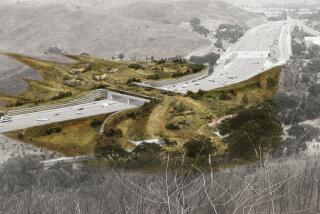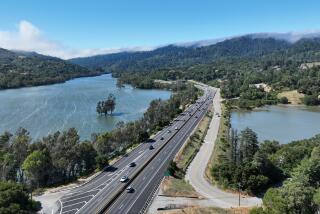The Next L.A. / Reinventing Our Future : Building a Better Overpass
- Share via
Structural engineers at UC San Diego and the defense industry are exploring ways to build the world’s first quake-resistant highway bridge, made entirely of lightweight composite materials like those used in bulletproof vests, boat hulls and the Stealth Bomber.
Last year, a $10.5 million federal grant was awarded to the landmark bridge project, which will connect the east and west campuses of UC San Diego over Interstate 5 in La Jolla. Construction will begin in three years and take about a year. When completed, the project will cost about $55 million including, research, development and construction.
Bridge Characteristics
Support: Bridge supported by series of cables connected to an A-frame pylon
Width: 60 feet
Span: 450 feet
Lanes: One 12-foot wide traffic lane in each direction, one bicycle lane in each direction
Walkway: 13-foot-wide pedestrian walkway
Pros and Cons
* A lighter bridge would be less sensitive to ground motion from earthquakes. A chunk of composite bridge deck big enough to fill a shopping cart can be held by two kindergarten-age children.
* It’s uncertain whether composites can withstand rain, heat or sun over long periods.
* Some composites are patented, which complicates Caltrans’ attempts to set generic standards.
* Composites can cost up to $150 a pound, compared with 50 cents a pound for concrete. But supporters say composites require less labor and are quicker, easier and less costlier in the long run.
More to Read
Sign up for Essential California
The most important California stories and recommendations in your inbox every morning.
You may occasionally receive promotional content from the Los Angeles Times.









